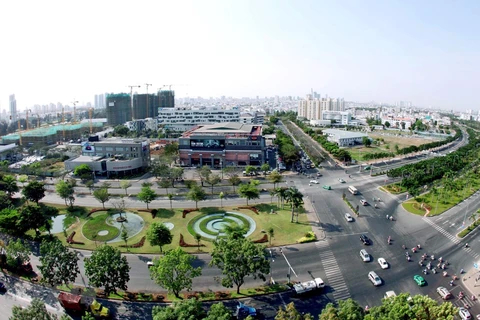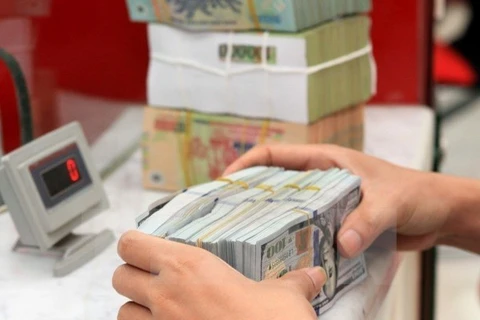HCM City (VNS/VNA) – Ho Chi Minh City’s Department of Industry and Trade has reported to the municipal administration that it is appraising tenders from contractors to develop logistics facilities and turn the city into a logistics hub for Southern Vietnam.
Nguyen Ngoc Hoa, deputy director of the department, said the project aims to develop the city into a national transshipment port with ports linked with Cai Mep-Thi Vai international port and build a network of inland container depots, reducing the high logistics costs.
The department will also hold conferences to discuss policies, regulations and funding to submit the project for the city’s approval in October.
HCM City aims to develop three logistic centres: one each in its south and north and one for aviation. The former two are expected to be at least 40 hectares in size in 2020 expanding to 70ha by 2030.
The city also targets annual growth of 25 percent for the logistics industry and for it to account for around 10 percent of its economy.
The project is part of the city’s efforts to foster socio-economic growth. Other efforts include speeding up projects that are lagging behind, equitising public businesses and pushing for smart city development.
HCM City has relatively developed logistics facilities and is the most important area in the southern key economic zones. According to the Vietnam Seaports Association, the city’s ports are leading in terms of the number of containers passing through, accounting for 58.8 percent of the whole country’s traffic.
The 130ha Tan Cang-Cat Lai Port in district 2, the biggest international port in Vietnam, accounts for 48 percent of the country’s container throughput due to its proximity to the city centre, industrial zones and storage spaces.
The 18.7ha Tan Cang-Hiep Phuoc Port is situated in the south of HCM City with roads connecting to various industrial zones, making it the main route for goods from these zones and the Mekong Delta.
Saigon Newport Corporation is investing more into the port, including in 300 hectares of storage space, container terminals and a general port.
District 9’s Sai Gon Hi-tech Park has a bonded warehouse and a well-equipped, 10ha logistics centre for domestic distribution and exports, and is located near provinces such as Dong Nai, Binh Duong and Ba Ria-Vung Tau.
However, logistics costs are higher in Vietnam than in most Southeast Asian countries but the sector’s contribution to the city’s economy is minimal.
The high costs also detract from Vietnamese goods’ competitiveness on the global market. The city also lacks rail links to ports.
Tan Son Nhat airport is bursting at the seams. In 2017, it handled 36 million passengers, which was far above the designed limit. A plan to upgrade capacity to 50 million a year was approved last year.
Several industry experts said to develop the city’s logistics, the market for high-quality, competitively-priced third party logistics services must be developed.
Better connectivity between ports and warehouses as well as more clarity and fairness in regulations and administration are needed, they said.
They said e-logistics using modern technologies and a central distribution network formed around locations such as airports and seaports for storing and distributing goods to the city distributors are also required.-VNS/VNA
Nguyen Ngoc Hoa, deputy director of the department, said the project aims to develop the city into a national transshipment port with ports linked with Cai Mep-Thi Vai international port and build a network of inland container depots, reducing the high logistics costs.
The department will also hold conferences to discuss policies, regulations and funding to submit the project for the city’s approval in October.
HCM City aims to develop three logistic centres: one each in its south and north and one for aviation. The former two are expected to be at least 40 hectares in size in 2020 expanding to 70ha by 2030.
The city also targets annual growth of 25 percent for the logistics industry and for it to account for around 10 percent of its economy.
The project is part of the city’s efforts to foster socio-economic growth. Other efforts include speeding up projects that are lagging behind, equitising public businesses and pushing for smart city development.
HCM City has relatively developed logistics facilities and is the most important area in the southern key economic zones. According to the Vietnam Seaports Association, the city’s ports are leading in terms of the number of containers passing through, accounting for 58.8 percent of the whole country’s traffic.
The 130ha Tan Cang-Cat Lai Port in district 2, the biggest international port in Vietnam, accounts for 48 percent of the country’s container throughput due to its proximity to the city centre, industrial zones and storage spaces.
The 18.7ha Tan Cang-Hiep Phuoc Port is situated in the south of HCM City with roads connecting to various industrial zones, making it the main route for goods from these zones and the Mekong Delta.
Saigon Newport Corporation is investing more into the port, including in 300 hectares of storage space, container terminals and a general port.
District 9’s Sai Gon Hi-tech Park has a bonded warehouse and a well-equipped, 10ha logistics centre for domestic distribution and exports, and is located near provinces such as Dong Nai, Binh Duong and Ba Ria-Vung Tau.
However, logistics costs are higher in Vietnam than in most Southeast Asian countries but the sector’s contribution to the city’s economy is minimal.
The high costs also detract from Vietnamese goods’ competitiveness on the global market. The city also lacks rail links to ports.
Tan Son Nhat airport is bursting at the seams. In 2017, it handled 36 million passengers, which was far above the designed limit. A plan to upgrade capacity to 50 million a year was approved last year.
Several industry experts said to develop the city’s logistics, the market for high-quality, competitively-priced third party logistics services must be developed.
Better connectivity between ports and warehouses as well as more clarity and fairness in regulations and administration are needed, they said.
They said e-logistics using modern technologies and a central distribution network formed around locations such as airports and seaports for storing and distributing goods to the city distributors are also required.-VNS/VNA
VNA
























